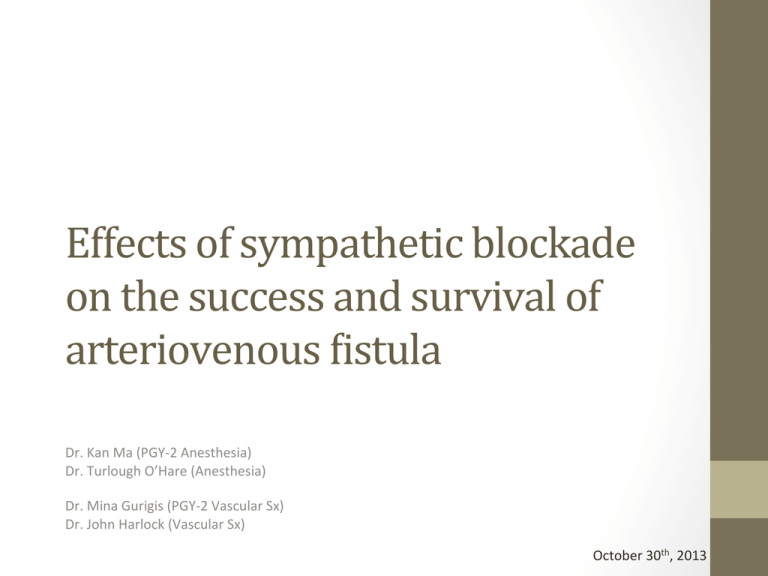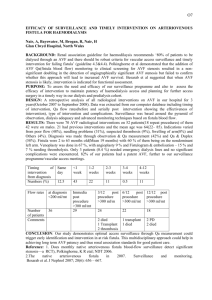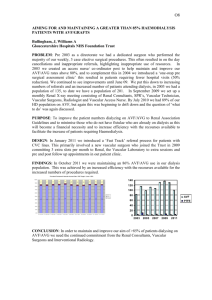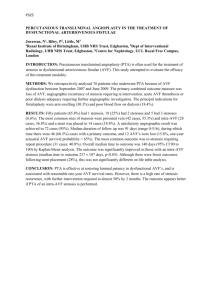Effects of sympathetic blockade on the success and survival of
advertisement

Effects of sympathetic blockade on the success and survival of arteriovenous 7istula Dr. Kan Ma (PGY-­‐2 Anesthesia) Dr. Turlough O’Hare (Anesthesia) Dr. Mina Gurigis (PGY-­‐2 Vascular Sx) Dr. John Harlock (Vascular Sx) October 30th, 2013 Arteriovenous 7istula Modified from healthgrades • AVF preferred over AVG for chronic HD • However, iniSal failure rates approximates 25% • Significant clinical and financial implicaSons Vascular Access Work G. 2006 Allon et al. 2002 AVF – What is adequate? • Rules of 6s • > 0.6 cm diameter • < 0.6 cm from skin surface • > 600 mL/min flow • Inadequate flow rate à thrombosis à loss of AVF • AVF flow may be compromised by arterial vasospasm and sympatheSc acSvity from surgery • Recent evidence suggests regional anesthesia may Vascular Access Work G. 2006 improve AVF flow Sidawy et al. 2002 He et al. 1997 Yildirim et al. 2006 Mercado et al. 2008 Malinzak et al. 2009 Anesthesia for AVF • Conducted under either A. General anesthesia (GA) B. Local anestheScs (LA) C. Regional anesthesia -­‐ Brachial plexus block (BPB) BPB for AVF • Sympathectomy associated w BPB • Enhances post-­‐anesthesia diameter and blood flow • Improves site-­‐selecSon for AVF creaSon • Enhances postop AVF blood flow • Associated w/ early patency • ? Beger long-­‐term patency? Reynolds et al. 2011 Mouquet et al. 1989 Shemesh et al. 2003 Shemesh et al. 2006 Li et al. 2012 SGB for AVF Modified from Miller’s Anesthesia 6th Ed Modified from azM anaesthesiology • Enhances postoperaSve AVF blood flow • Enhances average peak flow velocity • Shortens maturaSon Sme • ?Beger long-­‐term survival? Yildirim et al. 2006 BPB vs SGB vs LA? • Literature search on MEDLINE • no randomized trial has been conducted to directly compare axillary block (AB), stellate ganglion block (SGB) and LA alone on success and survival of AVF Hypothesis SympatheSc blockade with either axillary block or stellate ganglion block improves radiocephalic short-­‐term and long-­‐term patency as compared to local anestheScs infiltraSon alone. Inclusion criteria • 18-­‐65 yo • ESRD • Radio-­‐cephalic AVF formaSon Pa1ent from SJH Consent Randomiza1on Axillary Block SGB + LA Exclusion criteria • Previous AVF • stenosis or calcificaSons of RA or CV • RA diameter < 1.6 mm • CV diameter < 2.5 mm • Unilateral RLN or phrenic nerve palsy • Coagulopathy • AnScoagulants or anS-­‐ platelet therapies • IV drug use • Allergy to LA • Pregnancy • Morbid obesity LA Group AB Modified from NYSORA • Motor, sensory and sympatheSc blockade injected, and the needle was withdrawn. However, if the NaCl solution was observed above the fascia or within the muscle, the needle was gently repositioned before injection of the bupivacaine-iohexol mixture. Immediately after the injection, the patient was positioned supine, and anteroposterior and lateral Group SGB + LA Modified from NYSORA • SympatheSc blockade • Surgical site infiltraSon Modified Gofeld et al. 2009 FIGURE 4. Block needle (arrowheads) has been placed under the prevertebral fascia. Initial injection of 0.9% NaCl (asterisks) separates LCo from the fascia. durin to the stron FIGU the a preve the c musc musc * 2009 American Society of Regional Anesthesia and Pain Medicine Copyright @ 2009eAmerican Society of Regional Anesthesia and Pain Me • 15 mL of 0.25% bupivicaine without pinephrine Gofeld et al. 2009 Group LA • Surgical site infiltraSon only • 15 mL of 0.25% bupivicaine without epinephrine Axillary Block SGB + LA LA Infrared thermography Radiocephalic AVF ± Rescue opioid ± GA Minville et al. 2009 Radiocephalic AVF Primary outcomes • 3-­‐months primary patency rate Secondary outcomes • AVF blood flow • AVF diameter • Change in cephalic vein diameter pre-­‐ and post-­‐anestheSc • Change in radial artery diameter pre-­‐ and post-­‐anestheSc • 1-­‐year primary patency rate • 1-­‐year secondary patency rate • DuraSon of surgery • GA conversion • Total intraoperaSve narcoSc use • Adverse events • MaturaSon Sme • DuraSon of hospital stay • PaSent saSsfacSons Anticipated results • Group Axillary Block and SGB + LA >>> Group LA • • • • Higher 3-­‐months primary patency rate Higher 1 year primary patency rate Higher 1 year secondary patency rate Shorter maturaSon Sme Implications • First study to compare effect of SGB with axillary block on long-­‐term survival of AVF • Financial and clinical implicaSons Reference 1. 2. 3. 4. 5. 6. 7. 8. 9. 10. 11. 12. 13. Vascular Access Work G. Clinical pracSce guidelines for vascular access. American Journal of Kidney Diseases [Internet]. 2006 Jul;48(Suppl 1):S248-­‐73. Allon M, Robbin ML. Increasing arteriovenous fistulas in hemodialysis paSents: Problems and soluSons. Kidney Int [Internet]. 2002 Oct;62(4):1109-­‐24. Sidawy AN, Gray R, Besarab A, Henry M, Ascher E, Silva M,Jr, Miller A, Scher L, Trerotola S, Gregory RT, Rutherford RB, Kent KC. Recommended standards for reports dealing with arteriovenous hemodialysis accesses. Journal of Vascular Surgery [Internet]. 2002 Mar;35(3):603-­‐10. He GW, Yang CQ. Radial artery has higher receptor-­‐mediated contracSlity but similar endothelial funcSon compared with mammary artery. Ann Thorac Surg [Internet]. 1997 May;63(5):1346-­‐52. Yildirim V, Doganci S, Yanarates O, Saglam M, Kuralay E, Cosar A, Erdal Guzeldemi M. Does preempSve stellate ganglion blockage increase the patency of radiocephalic arteriovenous fistula?. Scandinavian Cardiovascular Journal [Internet]. 2006 Dec;40(6):380-­‐4. Mercado C, Salman L, Krishnamurthy G, Choi K, ArSkov S, Thomas I, Merrill D, Asif A. Early and late fistula failure. Clin Nephrol [Internet]. 2008 Feb;69(2):77-­‐83. Reynolds TS, Kim KM, DukkipaS R, Nguyen TH, Julka I, Kakazu C, Tokhner V, Chauvapun JP. Pre-­‐operaSve regional block anesthesia enhances operaSve strategy for arteriovenous fistula creaSon. J Vasc Access. 2011 Oct-­‐Dec;12(4):336-­‐40. Mouquet C, Bitker MO, Bailliart O, Rogembourg J, Clergue F, Montejo LS, MarSneaud JP, Viars P. Anesthesia for creaSon of a forearm fistula in paSents with endstage renal failure. Anesthesiology [Internet]. 1989 Jun;70(6):909-­‐14. Shemesh D, Zigelman C, Olsha O, Alberton J, Shapira J, Abramowitz H. Primary forearm arteriovenous fistula for hemodialysis access-­‐-­‐an integrated approach to improve outcomes. Cardiovascular Surgery [Internet]. 2003 Feb;11(1):35-­‐41. Shemesh D, Olsha O, Orkin D, Raveh D, Goldin I, Reichenstein Y, Zigelman C. Sympathectomy-­‐like effects of brachial plexus block in arteriovenous access surgery. Ultrasound Med Biol [Internet]. 2006 Jun;32(6):817-­‐22. Li J, Karmakar MK, Li X, Kwok WH, Ngan Kee WD. Regional hemodynamic changes auer an axillary brachial plexus block: A pulsed-­‐wave doppler ultrasound study. Regional Anesthesia & Pain Medicine [Internet]. 2012 Jan-­‐Feb;37(1):111-­‐8. Gofeld M, BhaSa A, Abbas S, Ganapathy S, Johnson M. Development and validaSon of a new technique for ultrasound-­‐guided stellate ganglion block. Regional Anesthesia & Pain Medicine [Internet]. 2009 Sep-­‐Oct;34(5):475-­‐9. Minville V, Gendre A, Hirsch J, Silva S, Bourdet B, Barbero C, Fourcade O, Samii K, Bouaziz H. The efficacy of skin temperature for block assessment auer infraclavicular brachial plexus block. Anesthesia & Analgesia [Internet]. 2009 Mar;108(3):1034-­‐6. Thank you • QuesSons?



